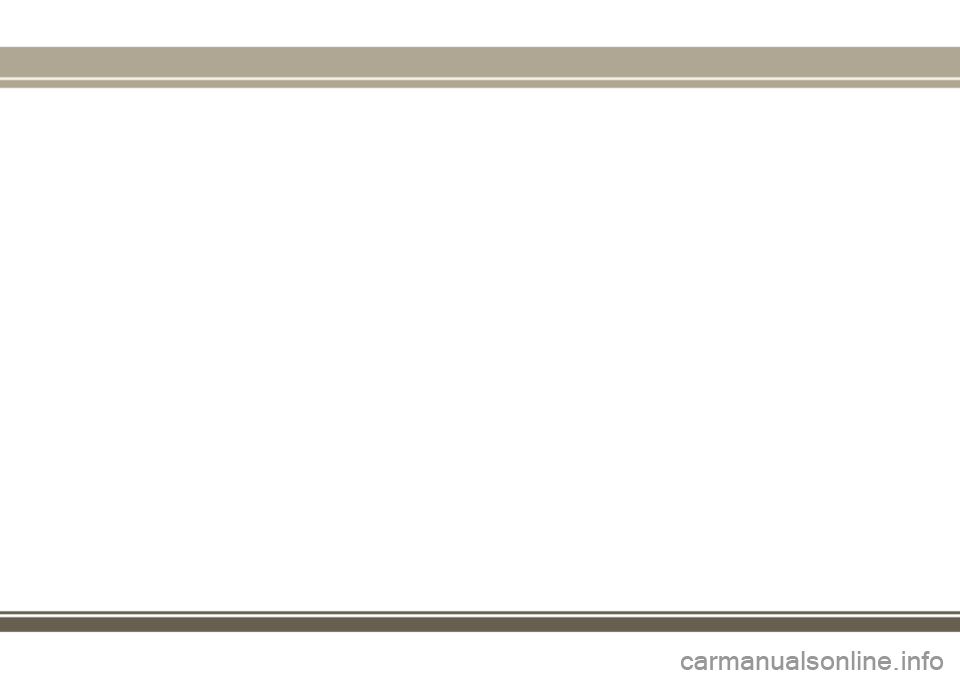JEEP RENEGADE 2018 Owner handbook (in English)
Manufacturer: JEEP, Model Year: 2018, Model line: RENEGADE, Model: JEEP RENEGADE 2018Pages: 356, PDF Size: 6.11 MB
Page 251 of 356
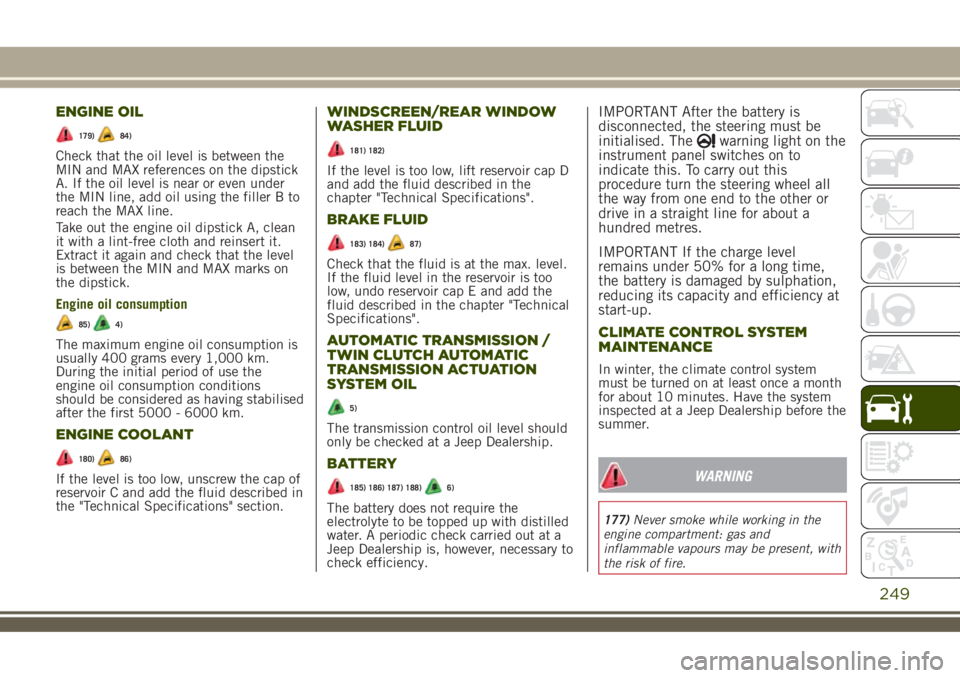
ENGINE OIL
179)84)
Check that the oil level is between the
MIN and MAX references on the dipstick
A. If the oil level is near or even under
the MIN line, add oil using the filler B to
reach the MAX line.
Take out the engine oil dipstick A, clean
it with a lint-free cloth and reinsert it.
Extract it again and check that the level
is between the MIN and MAX marks on
the dipstick.
Engine oil consumption
85)4)
The maximum engine oil consumption is
usually 400 grams every 1,000 km.
During the initial period of use the
engine oil consumption conditions
should be considered as having stabilised
after the first 5000 - 6000 km.
ENGINE COOLANT
180)86)
If the level is too low, unscrew the cap of
reservoir C and add the fluid described in
the "Technical Specifications" section.
WINDSCREEN/REAR WINDOW
WASHER FLUID
181) 182)
If the level is too low, lift reservoir cap D
and add the fluid described in the
chapter "Technical Specifications".
BRAKE FLUID
183) 184)87)
Check that the fluid is at the max. level.
If the fluid level in the reservoir is too
low, undo reservoir cap E and add the
fluid described in the chapter "Technical
Specifications".
AUTOMATIC TRANSMISSION /
TWIN CLUTCH AUTOMATIC
TRANSMISSION ACTUATION
SYSTEM OIL
5)
The transmission control oil level should
only be checked at a Jeep Dealership.
BATTERY
185) 186) 187) 188)6)
The battery does not require the
electrolyte to be topped up with distilled
water. A periodic check carried out at a
Jeep Dealership is, however, necessary to
check efficiency.
IMPORTANT After the battery is
disconnected, the steering must be
initialised. The
warning light on the
instrument panel switches on to
indicate this. To carry out this
procedure turn the steering wheel all
the way from one end to the other or
drive in a straight line for about a
hundred metres.
IMPORTANT If the charge level
remains under 50% for a long time,
the battery is damaged by sulphation,
reducing its capacity and efficiency at
start-up.
CLIMATE CONTROL SYSTEM
MAINTENANCE
In winter, the climate control system
must be turned on at least once a month
for about 10 minutes. Have the system
inspected at a Jeep Dealership before the
summer.
WARNING
177)Never smoke while working in the
engine compartment: gas and
inflammable vapours may be present, with
the risk of fire.
249
Page 252 of 356
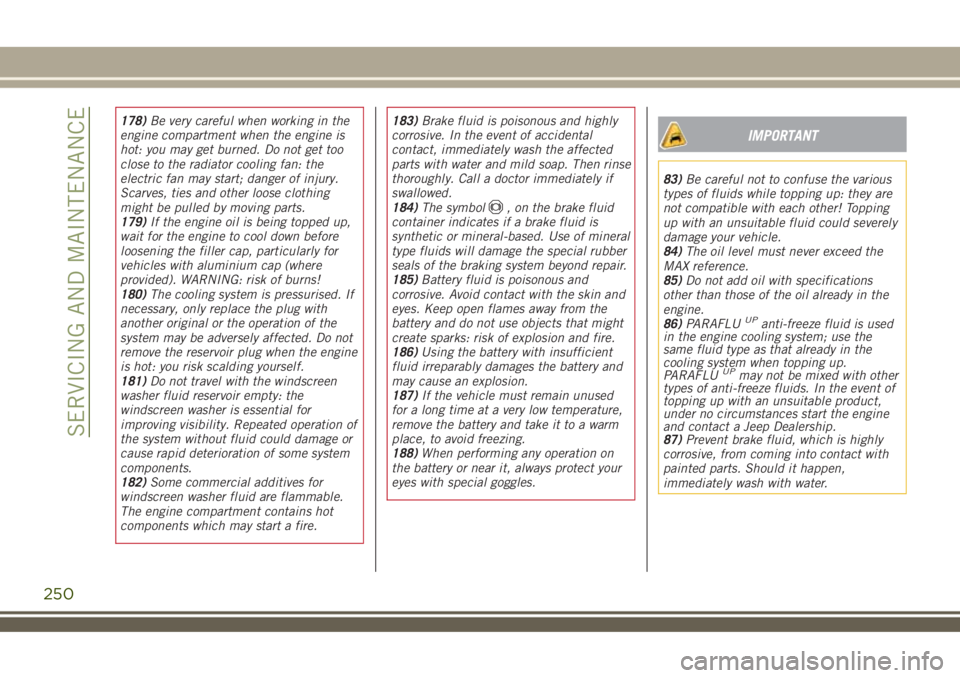
178)Be very careful when working in the
engine compartment when the engine is
hot: you may get burned. Do not get too
close to the radiator cooling fan: the
electric fan may start; danger of injury.
Scarves, ties and other loose clothing
might be pulled by moving parts.
179)If the engine oil is being topped up,
wait for the engine to cool down before
loosening the filler cap, particularly for
vehicles with aluminium cap (where
provided). WARNING: risk of burns!
180)The cooling system is pressurised. If
necessary, only replace the plug with
another original or the operation of the
system may be adversely affected. Do not
remove the reservoir plug when the engine
is hot: you risk scalding yourself.
181)Do not travel with the windscreen
washer fluid reservoir empty: the
windscreen washer is essential for
improving visibility. Repeated operation of
the system without fluid could damage or
cause rapid deterioration of some system
components.
182)Some commercial additives for
windscreen washer fluid are flammable.
The engine compartment contains hot
components which may start a fire.183)Brake fluid is poisonous and highly
corrosive. In the event of accidental
contact, immediately wash the affected
parts with water and mild soap. Then rinse
thoroughly. Call a doctor immediately if
swallowed.
184)The symbol
, on the brake fluid
container indicates if a brake fluid is
synthetic or mineral-based. Use of mineral
type fluids will damage the special rubber
seals of the braking system beyond repair.
185)Battery fluid is poisonous and
corrosive. Avoid contact with the skin and
eyes. Keep open flames away from the
battery and do not use objects that might
create sparks: risk of explosion and fire.
186)Using the battery with insufficient
fluid irreparably damages the battery and
may cause an explosion.
187)If the vehicle must remain unused
for a long time at a very low temperature,
remove the battery and take it to a warm
place, to avoid freezing.
188)When performing any operation on
the battery or near it, always protect your
eyes with special goggles.
IMPORTANT
83)Be careful not to confuse the various
types of fluids while topping up: they are
not compatible with each other! Topping
up with an unsuitable fluid could severely
damage your vehicle.
84)The oil level must never exceed the
MAX reference.
85)Do not add oil with specifications
other than those of the oil already in the
engine.
86)PARAFLU
UPanti-freeze fluid is used
in the engine cooling system; use the
same fluid type as that already in the
cooling system when topping up.
PARAFLU
UPmay not be mixed with other
types of anti-freeze fluids. In the event of
topping up with an unsuitable product,
under no circumstances start the engine
and contact a Jeep Dealership.
87)Prevent brake fluid, which is highly
corrosive, from coming into contact with
painted parts. Should it happen,
immediately wash with water.
250
SERVICING AND MAINTENANCE
Page 253 of 356
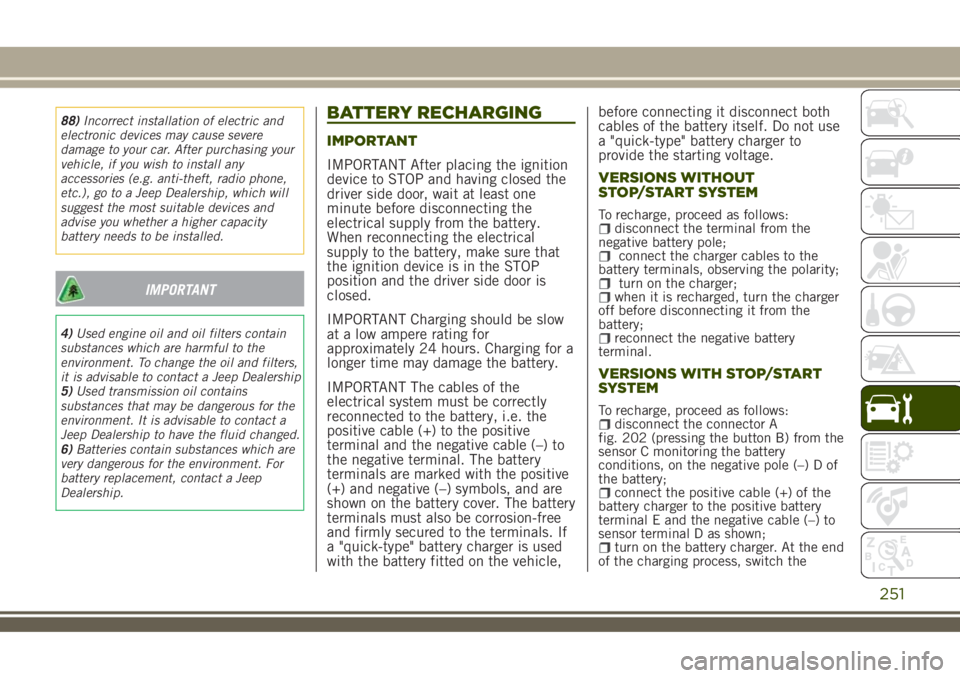
88)Incorrect installation of electric and
electronic devices may cause severe
damage to your car. After purchasing your
vehicle, if you wish to install any
accessories (e.g. anti-theft, radio phone,
etc.), go to a Jeep Dealership, which will
suggest the most suitable devices and
advise you whether a higher capacity
battery needs to be installed.
IMPORTANT
4)Used engine oil and oil filters contain
substances which are harmful to the
environment. To change the oil and filters,
it is advisable to contact a Jeep Dealership
5)Used transmission oil contains
substances that may be dangerous for the
environment. It is advisable to contact a
Jeep Dealership to have the fluid changed.
6)Batteries contain substances which are
very dangerous for the environment. For
battery replacement, contact a Jeep
Dealership.
BATTERY RECHARGING
IMPORTANT
IMPORTANT After placing the ignition
device to STOP and having closed the
driver side door, wait at least one
minute before disconnecting the
electrical supply from the battery.
When reconnecting the electrical
supply to the battery, make sure that
the ignition device is in the STOP
position and the driver side door is
closed.
IMPORTANT Charging should be slow
at a low ampere rating for
approximately 24 hours. Charging for a
longer time may damage the battery.
IMPORTANT The cables of the
electrical system must be correctly
reconnected to the battery, i.e. the
positive cable (+) to the positive
terminal and the negative cable (–) to
the negative terminal. The battery
terminals are marked with the positive
(+) and negative (–) symbols, and are
shown on the battery cover. The battery
terminals must also be corrosion-free
and firmly secured to the terminals. If
a "quick-type" battery charger is used
with the battery fitted on the vehicle,before connecting it disconnect both
cables of the battery itself. Do not use
a "quick-type" battery charger to
provide the starting voltage.
VERSIONS WITHOUT
STOP/START SYSTEM
To recharge, proceed as follows:disconnect the terminal from the
negative battery pole;
connect the charger cables to the
battery terminals, observing the polarity;
turn on the charger;when it is recharged, turn the charger
off before disconnecting it from the
battery;
reconnect the negative battery
terminal.
VERSIONS WITH STOP/START
SYSTEM
To recharge, proceed as follows:disconnect the connector A
fig. 202 (pressing the button B) from the
sensor C monitoring the battery
conditions, on the negative pole (–) D of
the battery;
connect the positive cable (+) of the
battery charger to the positive battery
terminal E and the negative cable (–) to
sensor terminal D as shown;
turn on the battery charger. At the end
of the charging process, switch the
251
Page 254 of 356
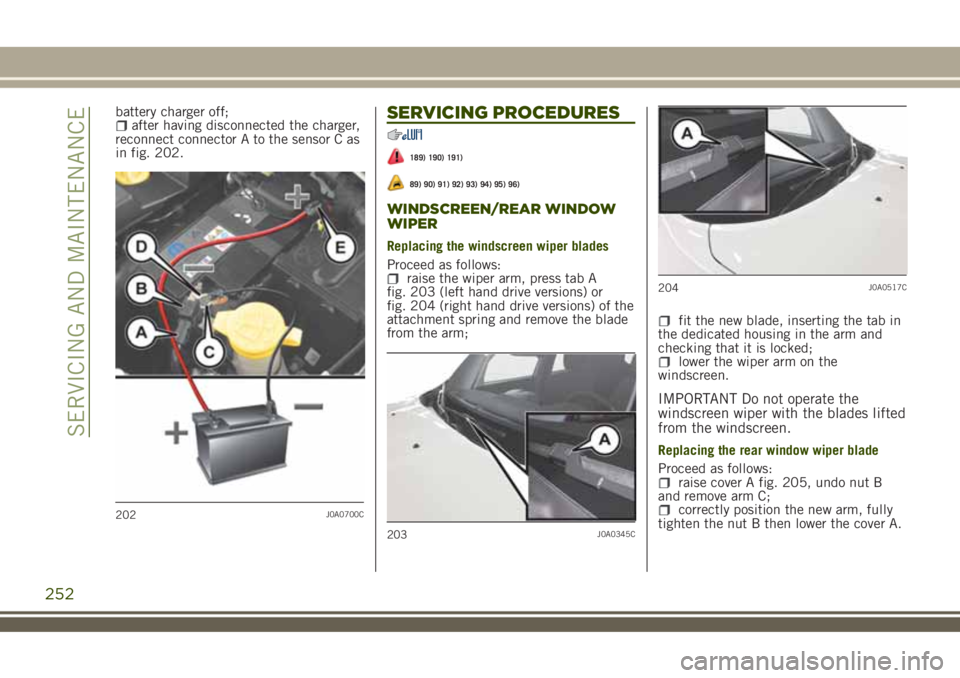
battery charger off;after having disconnected the charger,
reconnect connector A to the sensor C as
in fig. 202.SERVICING PROCEDURES
189) 190) 191)
89) 90) 91) 92) 93) 94) 95) 96)
WINDSCREEN/REAR WINDOW
WIPER
Replacing the windscreen wiper blades
Proceed as follows:
raise the wiper arm, press tab A
fig. 203 (left hand drive versions) or
fig. 204 (right hand drive versions) of the
attachment spring and remove the blade
from the arm;
fit the new blade, inserting the tab in
the dedicated housing in the arm and
checking that it is locked;
lower the wiper arm on the
windscreen.
IMPORTANT Do not operate the
windscreen wiper with the blades lifted
from the windscreen.
Replacing the rear window wiper blade
Proceed as follows:
raise cover A fig. 205, undo nut B
and remove arm C;
correctly position the new arm, fully
tighten the nut B then lower the cover A.202J0A0700C
203J0A0345C
204J0A0517C
252
SERVICING AND MAINTENANCE
Page 255 of 356
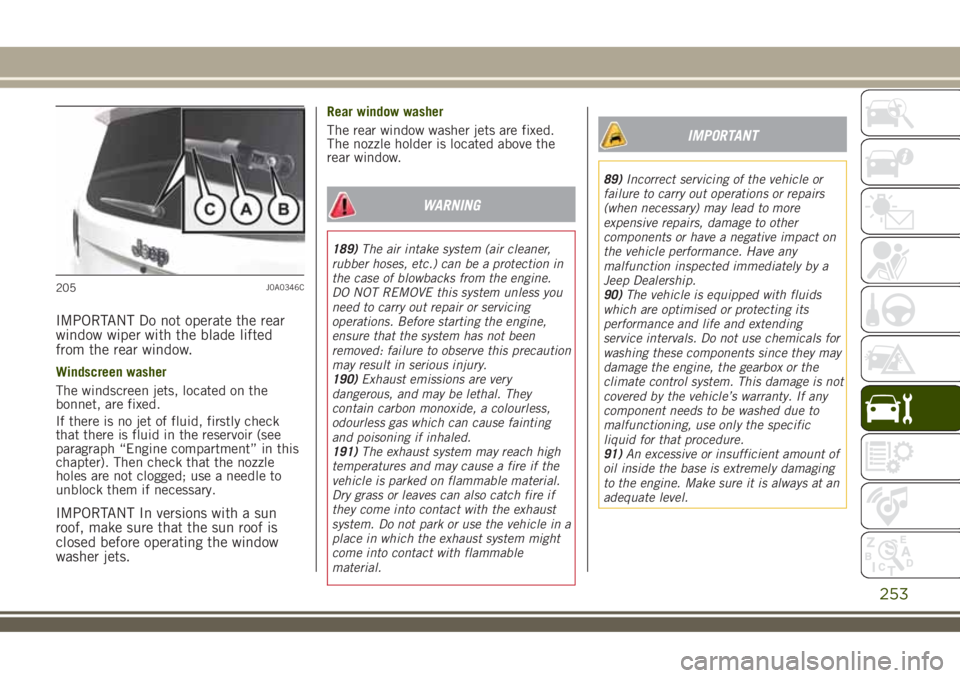
IMPORTANT Do not operate the rear
window wiper with the blade lifted
from the rear window.
Windscreen washer
The windscreen jets, located on the
bonnet, are fixed.
If there is no jet of fluid, firstly check
that there is fluid in the reservoir (see
paragraph “Engine compartment” in this
chapter). Then check that the nozzle
holes are not clogged; use a needle to
unblock them if necessary.
IMPORTANT In versions with a sun
roof, make sure that the sun roof is
closed before operating the window
washer jets.
Rear window washer
The rear window washer jets are fixed.
The nozzle holder is located above the
rear window.
WARNING
189)The air intake system (air cleaner,
rubber hoses, etc.) can be a protection in
the case of blowbacks from the engine.
DO NOT REMOVE this system unless you
need to carry out repair or servicing
operations. Before starting the engine,
ensure that the system has not been
removed: failure to observe this precaution
may result in serious injury.
190)Exhaust emissions are very
dangerous, and may be lethal. They
contain carbon monoxide, a colourless,
odourless gas which can cause fainting
and poisoning if inhaled.
191)The exhaust system may reach high
temperatures and may cause a fire if the
vehicle is parked on flammable material.
Dry grass or leaves can also catch fire if
they come into contact with the exhaust
system. Do not park or use the vehicle in a
place in which the exhaust system might
come into contact with flammable
material.
IMPORTANT
89)Incorrect servicing of the vehicle or
failure to carry out operations or repairs
(when necessary) may lead to more
expensive repairs, damage to other
components or have a negative impact on
the vehicle performance. Have any
malfunction inspected immediately by a
Jeep Dealership.
90)The vehicle is equipped with fluids
which are optimised or protecting its
performance and life and extending
service intervals. Do not use chemicals for
washing these components since they may
damage the engine, the gearbox or the
climate control system. This damage is not
covered by the vehicle’s warranty. If any
component needs to be washed due to
malfunctioning, use only the specific
liquid for that procedure.
91)An excessive or insufficient amount of
oil inside the base is extremely damaging
to the engine. Make sure it is always at an
adequate level.
205J0A0346C
253
Page 256 of 356
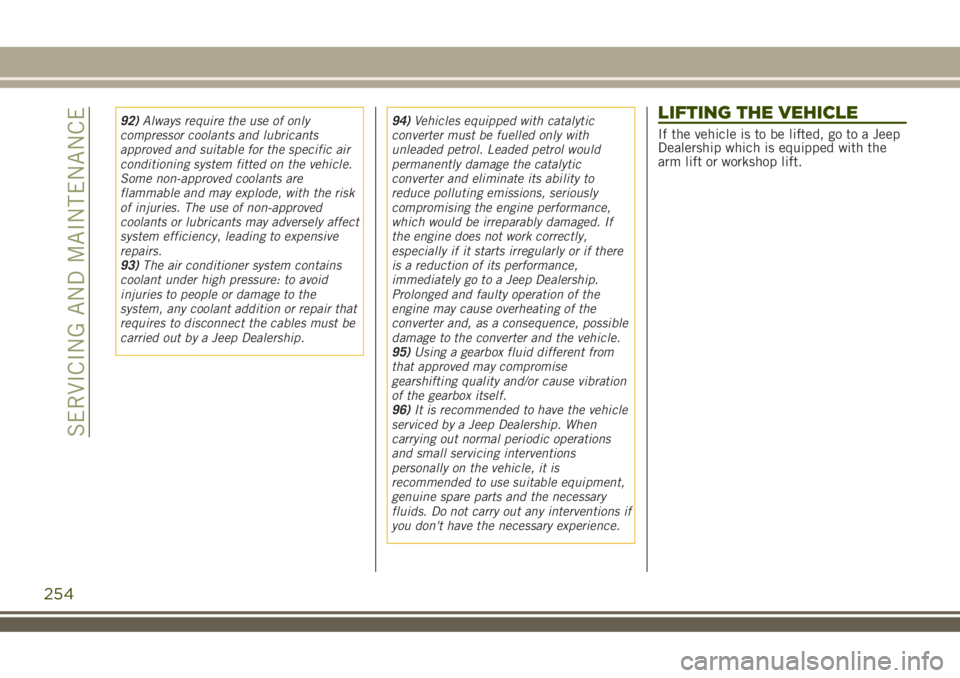
92)Always require the use of only
compressor coolants and lubricants
approved and suitable for the specific air
conditioning system fitted on the vehicle.
Some non-approved coolants are
flammable and may explode, with the risk
of injuries. The use of non-approved
coolants or lubricants may adversely affect
system efficiency, leading to expensive
repairs.
93)The air conditioner system contains
coolant under high pressure: to avoid
injuries to people or damage to the
system, any coolant addition or repair that
requires to disconnect the cables must be
carried out by a Jeep Dealership.94)Vehicles equipped with catalytic
converter must be fuelled only with
unleaded petrol. Leaded petrol would
permanently damage the catalytic
converter and eliminate its ability to
reduce polluting emissions, seriously
compromising the engine performance,
which would be irreparably damaged. If
the engine does not work correctly,
especially if it starts irregularly or if there
is a reduction of its performance,
immediately go to a Jeep Dealership.
Prolonged and faulty operation of the
engine may cause overheating of the
converter and, as a consequence, possible
damage to the converter and the vehicle.
95)Using a gearbox fluid different from
that approved may compromise
gearshifting quality and/or cause vibration
of the gearbox itself.
96)It is recommended to have the vehicle
serviced by a Jeep Dealership. When
carrying out normal periodic operations
and small servicing interventions
personally on the vehicle, it is
recommended to use suitable equipment,
genuine spare parts and the necessary
fluids. Do not carry out any interventions if
you don't have the necessary experience.LIFTING THE VEHICLE
If the vehicle is to be lifted, go to a Jeep
Dealership which is equipped with the
arm lift or workshop lift.
254
SERVICING AND MAINTENANCE
Page 257 of 356
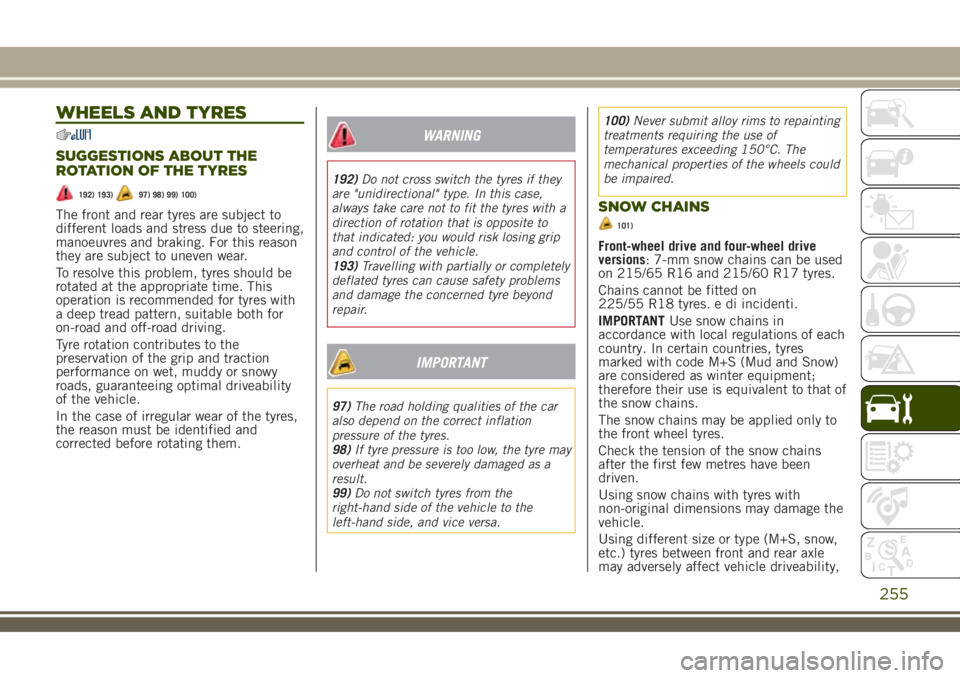
WHEELS AND TYRES
SUGGESTIONS ABOUT THE
ROTATION OF THE TYRES
192) 193)97) 98) 99) 100)
The front and rear tyres are subject to
different loads and stress due to steering,
manoeuvres and braking. For this reason
they are subject to uneven wear.
To resolve this problem, tyres should be
rotated at the appropriate time. This
operation is recommended for tyres with
a deep tread pattern, suitable both for
on-road and off-road driving.
Tyre rotation contributes to the
preservation of the grip and traction
performance on wet, muddy or snowy
roads, guaranteeing optimal driveability
of the vehicle.
In the case of irregular wear of the tyres,
the reason must be identified and
corrected before rotating them.
WARNING
192)Do not cross switch the tyres if they
are "unidirectional" type. In this case,
always take care not to fit the tyres with a
direction of rotation that is opposite to
that indicated: you would risk losing grip
and control of the vehicle.
193)Travelling with partially or completely
deflated tyres can cause safety problems
and damage the concerned tyre beyond
repair.
IMPORTANT
97)The road holding qualities of the car
also depend on the correct inflation
pressure of the tyres.
98)If tyre pressure is too low, the tyre may
overheat and be severely damaged as a
result.
99)Do not switch tyres from the
right-hand side of the vehicle to the
left-hand side, and vice versa.100)Never submit alloy rims to repainting
treatments requiring the use of
temperatures exceeding 150°C. The
mechanical properties of the wheels could
be impaired.
SNOW CHAINS
101)
Front-wheel drive and four-wheel drive
versions: 7-mm snow chains can be used
on 215/65 R16 and 215/60 R17 tyres.
Chains cannot be fitted on
225/55 R18 tyres. e di incidenti.
IMPORTANTUse snow chains in
accordance with local regulations of each
country. In certain countries, tyres
marked with code M+S (Mud and Snow)
are considered as winter equipment;
therefore their use is equivalent to that of
the snow chains.
The snow chains may be applied only to
the front wheel tyres.
Check the tension of the snow chains
after the first few metres have been
driven.
Using snow chains with tyres with
non-original dimensions may damage the
vehicle.
Using different size or type (M+S, snow,
etc.) tyres between front and rear axle
may adversely affect vehicle driveability,
255
Page 258 of 356
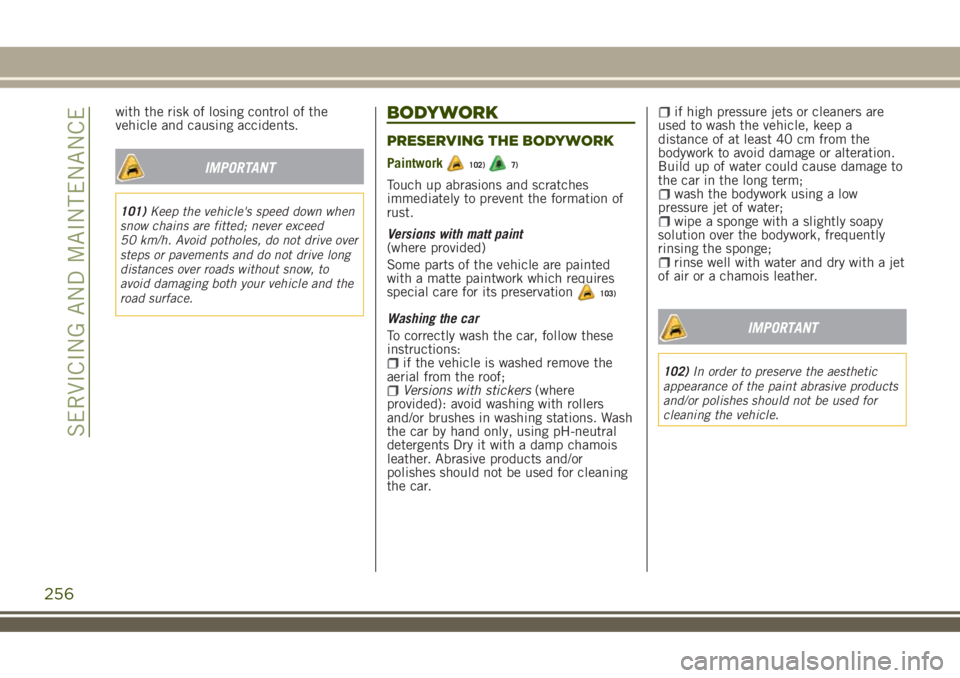
with the risk of losing control of the
vehicle and causing accidents.
IMPORTANT
101)Keep the vehicle's speed down when
snow chains are fitted; never exceed
50 km/h. Avoid potholes, do not drive over
steps or pavements and do not drive long
distances over roads without snow, to
avoid damaging both your vehicle and the
road surface.
BODYWORK
PRESERVING THE BODYWORK
Paintwork102)7)
Touch up abrasions and scratches
immediately to prevent the formation of
rust.
Versions with matt paint
(where provided)
Some parts of the vehicle are painted
with a matte paintwork which requires
special care for its preservation
103)
Washing the car
To correctly wash the car, follow these
instructions:
if the vehicle is washed remove the
aerial from the roof;
Versions with stickers(where
provided): avoid washing with rollers
and/or brushes in washing stations. Wash
the car by hand only, using pH-neutral
detergents Dry it with a damp chamois
leather. Abrasive products and/or
polishes should not be used for cleaning
the car.
if high pressure jets or cleaners are
used to wash the vehicle, keep a
distance of at least 40 cm from the
bodywork to avoid damage or alteration.
Build up of water could cause damage to
the car in the long term;
wash the bodywork using a low
pressure jet of water;
wipe a sponge with a slightly soapy
solution over the bodywork, frequently
rinsing the sponge;
rinse well with water and dry with a jet
of air or a chamois leather.
IMPORTANT
102)In order to preserve the aesthetic
appearance of the paint abrasive products
and/or polishes should not be used for
cleaning the vehicle.
256
SERVICING AND MAINTENANCE
Page 259 of 356
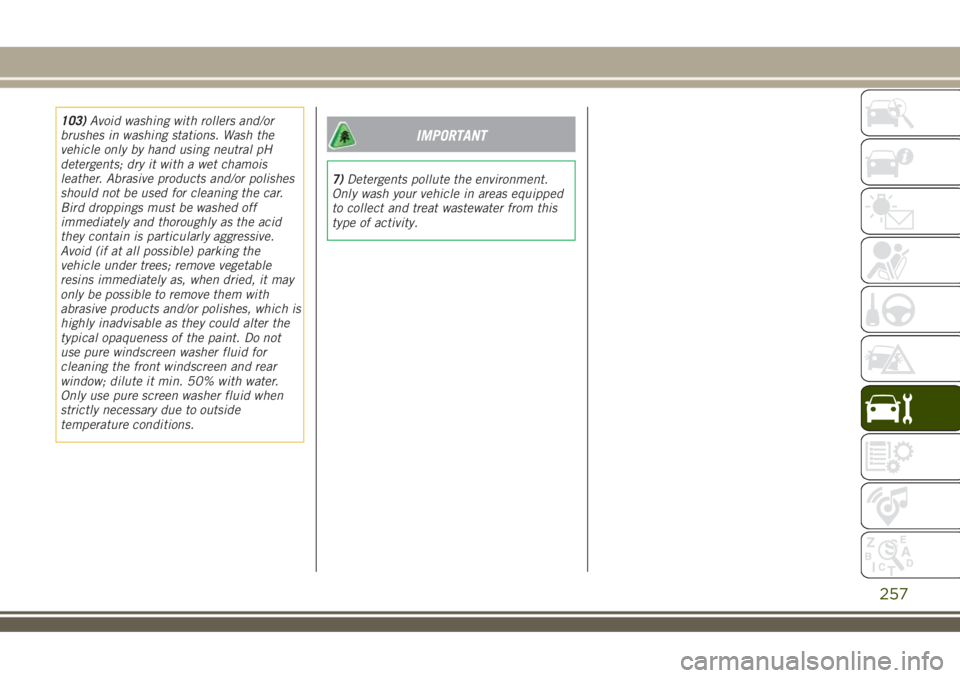
103)Avoid washing with rollers and/or
brushes in washing stations. Wash the
vehicle only by hand using neutral pH
detergents; dry it with a wet chamois
leather. Abrasive products and/or polishes
should not be used for cleaning the car.
Bird droppings must be washed off
immediately and thoroughly as the acid
they contain is particularly aggressive.
Avoid (if at all possible) parking the
vehicle under trees; remove vegetable
resins immediately as, when dried, it may
only be possible to remove them with
abrasive products and/or polishes, which is
highly inadvisable as they could alter the
typical opaqueness of the paint. Do not
use pure windscreen washer fluid for
cleaning the front windscreen and rear
window; dilute it min. 50% with water.
Only use pure screen washer fluid when
strictly necessary due to outside
temperature conditions.IMPORTANT
7)Detergents pollute the environment.
Only wash your vehicle in areas equipped
to collect and treat wastewater from this
type of activity.
257
Page 260 of 356
